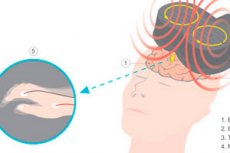New publications
Q&A: What to do if depression medications don't work
Last reviewed: 02.07.2025

All iLive content is medically reviewed or fact checked to ensure as much factual accuracy as possible.
We have strict sourcing guidelines and only link to reputable media sites, academic research institutions and, whenever possible, medically peer reviewed studies. Note that the numbers in parentheses ([1], [2], etc.) are clickable links to these studies.
If you feel that any of our content is inaccurate, out-of-date, or otherwise questionable, please select it and press Ctrl + Enter.

About 30-40% of patients do not respond to medications for depression and obsessive-compulsive disorder (OCD), but half of them may benefit from a noninvasive office procedure.
In honor of National Mental Health Awareness Month in May, we speak with psychiatrist Katherine Scangos, MD, PhD, co-director of the Transcranial Magnetic Stimulation (TMS) and Neuromodulation Program at UC San Francisco.
TMS is a logical next step for many patients who have had an inadequate response to standard treatment, according to Scangos, who is affiliated with the UCSF Weill Institute for Neurosciences and is an assistant professor of clinical psychiatry.
Scangos is especially pleased for patients who have found success with TMS after long periods of depression. She admires those who have been able to reconnect with family and friends, make plans, and engage in activities they had put off.
How does TMS work?
The treatment involves delivering brief magnetic pulses to the brain via an electromagnetic coil placed on the patient’s head. This causes electrical currents that stimulate nerve cells in specific areas of the brain. In patients with depression, the target area is the dorsolateral prefrontal cortex, a part of the brain involved in the cognitive processing of emotion. In OCD, the pulses are delivered to other parts of the prefrontal cortex associated with repetitive behaviors.
Most of our patients undergo a newer version of TMS known as intermittent theta stimulation, which takes only three minutes. Because no sedation is required and side effects, if any, are minimal (the most common being scalp irritation), patients can return home or to work immediately after the treatment. A course of treatment typically consists of 20 to 30 sessions over four to six weeks.
How quickly does it start working?
Some patients begin to feel better in one to two weeks. Others may need four weeks or longer. Depression and OCD can be lifelong disorders, and repeated treatments may be needed over months or years.
For patients with depression undergoing TMS, half can experience at least a 50% reduction in symptoms. For those with OCD, half can experience at least a 35% reduction in symptoms.
What are the criteria for TMS?
Most patients have major depressive disorder and have had several courses of medication and counseling with more than one therapist before considering TMS. Insurance companies typically require that patients with depression or OCD, which often accompanies depression, have not shown significant improvement after trying at least two medications. We work with patients from about 21 to 70 years old, but we consider each individual individually.
Who is not suitable for TMS?
Patients with anxiety disorders without depression may not respond to TMS. People who are pregnant, have a high risk of seizures, have epilepsy, or have metal implants in their heads should not undergo this treatment.
TMS is not an appropriate first step for patients in crisis who require immediate relief. The drug esketamine (Spravato) can improve mood within hours or days. Electroconvulsive therapy (ECT) can relieve symptoms more quickly than TMS and is more effective. But it involves the use of anesthesia and electrical stimulation to induce seizures, making it more invasive than TMS.
Research is exploring the use of the therapy for chronic pain, anorexia, post-traumatic stress disorder, schizophrenia, anxiety and addiction. Results are encouraging for some, but not all, of these conditions.
Do patients continue to take antidepressants and therapy?
We ask patients to continue their usual medications and psychotherapy during TMS and for at least a year after treatment. Often medications provide some benefit, but are not enough to eliminate symptoms. We also find that patients become more receptive to psychotherapy as TMS progresses and mood improves.
How do you know when a patient is getting better?
We monitor patients’ scores using a test that assesses symptoms such as decreased appetite and sleep, difficulty concentrating, sadness, inner tension, and slowness in performing daily activities. And we look for signs that patients’ emotions have improved and that they are becoming more sociable and expressive.
We find that they are doing household chores, perhaps doing laundry and cooking dinner. They tell us that they are calling friends, watching movies and TV shows that make them laugh – activities they haven’t done in months or years. It’s very rewarding when patients reach this stage of recovery.
